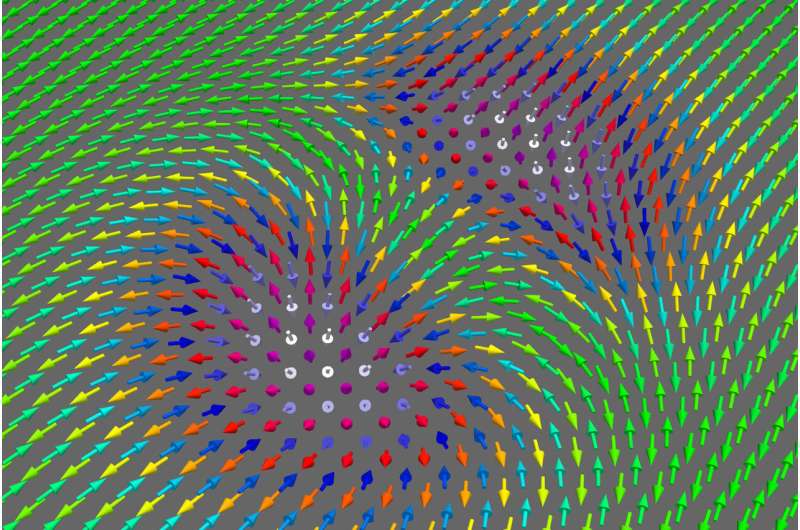Antiferromagnetic bimeron shows chaotic behaviors

Magnetic bimeron is a topological spin texture with particle-like characteristics, which can exist in chiral magnets with in-plane magnetic anisotropy. The magnetic bimeron with topological charge of one can be regarded as a counterpart of the magnetic skyrmion in perpendicularly magnetized systems. So far, the studies on magnetic bimerons focus on the ferromagnetic systems. The dynamics of the bimeron in antiferromagnets still remain elusive.
Recently, an international research team from China, Japan, and Australia theoretically studied the dynamics of antiferromagnetic bimerons. They predicted the stabilization of the isolated bimerons in antiferromagnets and numerically demonstrated the creation and current-induced motion of an isolated bimeron in the antiferromagnetic thin film. They also revealed that the motion of an antiferromagnetic bimeron induced by alternating currents obeys the well-known Duffing equation, which describes the oscillation of an object with a mass under the action of nonlinear restoring forces. For a nonlinear system, chaotic behavior can be found. By calculating bifurcation diagrams and Lyapunov exponents, it is found that the periodic and chaotic movements appear at intervals when the damping constant and driving current density are varied. The results are useful for understanding of bimeron physics in antiferromagnets and may provide guidelines for building spintronic devices based on bimerons.
The results have been published in the journal Physical Review Letters, in a paper by Prof. Yan Zhou's Group from The Chinese University of Hong Kong, Shenzhen, and four collaborators from Sichuan Normal University, China, The University of Tokyo, Japan, Shinshu University, Japan, and the University of New South Wales, Australia.
"Because of the spin structure characteristics of antiferromagnets, antiferromagnetic spin textures have richer dynamics than ferromagnetic ones," says Mr. Laichuan Shen, a researcher at The Chinese University of Hong Kong, Shenzhen, and the first author of the study. "We use the spin current to create the antiferromagnetic bimeron, and to drive it at a speed of a few kilometers per second without any transverse drift. Also, we find that when an alternating current is applied to drive the antiferromagnetic bimeron, its equation of motion is the well-known Duffing equation, and its motion behavior is chaotic for certain parameter values."
"Because in two-sublattice antiferromagnets the Magnus force is completely canceled out the antiferromagnetic bimeron can move directly along the applied current, which can be crucial for spintronic devices. Moreover, the chaotic behavior of these bimerons in the presence of ac-drive in low-damping antiferromagnets may be beneficial for stochastic applications, such as neuromorphic computing," explains Dr. Oleg A. Tretiakov, senior lecturer at the University of New South Wales, and the co-author of this study.
"The antiferromagnetic bimeron is possible to be used as the Duffing oscillator, and the proposal of such an antiferromagnetic spin texture may potentially create many exciting opportunities for the emerging field," explains Prof. Yan Zhou, associate professor of the Chinese University of Hong Kong, Shenzhen, and the corresponding author of the study.
"In the past 10 years, most studies in the field have focused on skyrmions in ferromagnetic materials, while skyrmions and other topological spin textures can also exist in antiferromagnetic materials. Our work shows the antiferromagnetic topological spin textures could be as useful as ferromagnetic ones," says Prof. Guoping Zhao, Professor of Sichuan Normal University, and the other corresponding author of the study.
More information: Laichuan Shen et al. Current-Induced Dynamics and Chaos of Antiferromagnetic Bimerons, Physical Review Letters (2020). DOI: 10.1103/PhysRevLett.124.037202
Journal information: Physical Review Letters
Provided by The Chinese University of Hong Kong, Shenzhen





















